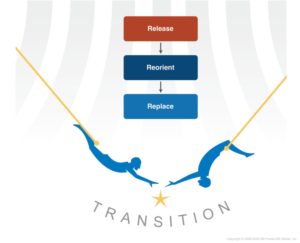Leading a Transformation Requires Both
Change is situational—it involves changing from one situation or context to another. For example, I change how I process invoices; I use new software; I relocate to another place. Change is behavioral. You can get people to change their behavior and hold them accountable by observing performance and tangible results, but you cannot make them internalize the change. You must allow time and support to help them go through the emotions involved in transitioning toward the new situation.
Transition is mindset and attitude—a transition occurs when the emotions catch up to the situation: the new way of invoicing makes me feel less confident, fearful, or uncomfortable; the new software makes me feel uncertain or anxious; or the new location makes me feel sentimental and more nostalgic for the old location—a sense of loss. Transition is psychological. Transition can be described as a psychological process that allows people to come to terms with situational changes.
Insights on the Nature of Transition
Let’s now explore the nature of transition—and discover the five insights that naturally come with it.
- Transition is not optional. Everyone who changes from one situation or context to another must make the transition. If you don’t make the transition, you don’t transform.
- Transition is psychological. Again, most of the resistance you feel during this time is caused by emotions catching up to reality. So make sure you put on your game eyes, look through the trees, and see the root issues. For example, the immigration conflict at the U.S. border is an emotional issue; leaders have to consider the emotional elements to create an appropriate range of options.
- Transition is chaotic. Don’t plan on everything going exactly as planned! In transformations, you have to learn to deal with ambiguity. So, be flexible, and adapt while you are simultaneously helping others work through it. And if you didn’t plan for resources to cover the chaos, you have to be resourceful.
- Transition is painful. It will not be easy because it is about internalizing the changes and dealing with a loss! To transition, you always have to give up something. If you go into it thinking you will not experience any pain, you will have a strategy that backfires, and you will make the transition even more painful and drawn out.
- Transition surfaces hidden agendas. People you thought were on your side earlier may suddenly and surprisingly turn against you and the vision, especially when the transition begins to affect their personal space or when they feel incompetent in the new, demanding situation. This attitude shows up in those people who have the mental mindset of “my position is my identity.”
Think of a major change (a situation like a divorce, a move to a new city, or a change in careers) that you have experienced in your personal or professional life. Note the psychological elements involved in the transition and the emotions you had to grapple with to complete the transformational change.
In transition, you may experience such emotions as anger, anxiety, fear, grief, loss, uncertainty, confusion, loneliness, regret, overreaction, or excitement. These are natural emotional responses that go along with the transition.
The visual we use to capture the essence of transformation – both the situational and emotional aspects – is captured in the trapeze artist. We’ll speak to this in more detail in Part 2, Understand the 3 Major Phases of Transition.

Copyright © 2023 J2N Global







